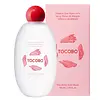What's inside
What's inside
 Key Ingredients
Key Ingredients

 Benefits
Benefits

 Concerns
Concerns

 Ingredients Side-by-side
Ingredients Side-by-side

Water
Skin ConditioningCitrus Limon Fruit Extract
MaskingGlycolic Acid
BufferingMethylpropanediol
SolventAlcohol Denat.
AntimicrobialSodium Hydroxide
BufferingDipropylene Glycol
HumectantSphingomonas Ferment Extract
Skin ConditioningCitrus Limon Peel Oil
MaskingSodium Hyaluronate
HumectantOzothamnus Diosmifolius Extract
Citrus Aurantium Dulcis Peel Oil
MaskingCitrus Aurantifolia Oil
CleansingRose Flower Oil
MaskingFortunella Margarita Peel Oil
Lavandula Angustifolia Oil
MaskingRosmarinus Officinalis Leaf Oil
MaskingAlthaea Rosea Flower Extract
Skin ConditioningCitrus Aurantium Bergamia Fruit Oil
Masking1,2-Hexanediol
Skin ConditioningOctyldodeceth-16
EmulsifyingPhosphorus Pentoxide
BufferingPanthenol
Skin ConditioningButylene Glycol
HumectantSalicylic Acid
MaskingAllantoin
Skin ConditioningPentylene Glycol
Skin ConditioningBeta-Glucan
Skin ConditioningCaprylyl Glycol
EmollientEthylhexylglycerin
Skin ConditioningPhenoxyethanol
PreservativeLimonene
PerfumingCitral
PerfumingWater, Citrus Limon Fruit Extract, Glycolic Acid, Methylpropanediol, Alcohol Denat., Sodium Hydroxide, Dipropylene Glycol, Sphingomonas Ferment Extract, Citrus Limon Peel Oil, Sodium Hyaluronate, Ozothamnus Diosmifolius Extract, Citrus Aurantium Dulcis Peel Oil, Citrus Aurantifolia Oil, Rose Flower Oil, Fortunella Margarita Peel Oil, Lavandula Angustifolia Oil, Rosmarinus Officinalis Leaf Oil, Althaea Rosea Flower Extract, Citrus Aurantium Bergamia Fruit Oil, 1,2-Hexanediol, Octyldodeceth-16, Phosphorus Pentoxide, Panthenol, Butylene Glycol, Salicylic Acid, Allantoin, Pentylene Glycol, Beta-Glucan, Caprylyl Glycol, Ethylhexylglycerin, Phenoxyethanol, Limonene, Citral
Water
Skin ConditioningHippophae Rhamnoides Water
MaskingDipropylene Glycol
HumectantC12-14 Alketh-12
EmulsifyingButylene Glycol
HumectantChlorella Vulgaris Extract
Skin ConditioningGlucose
HumectantFragaria Vesca Fruit Extract
AstringentHibiscus Sabdariffa Flower Extract
Skin ConditioningBetaine
HumectantFructooligosaccharides
HumectantFructose
HumectantGlycerin
HumectantEthylhexylglycerin
Skin ConditioningParfum
MaskingDipotassium Glycyrrhizate
HumectantMenthol
MaskingSodium Citrate
BufferingCarbomer
Emulsion StabilisingTromethamine
BufferingCaprylyl Glycol
EmollientCitric Acid
BufferingCynanchum Atratum Extract
Skin ConditioningBeta-Glucan
Skin ConditioningAlthaea Rosea Flower Extract
Skin ConditioningTocopherol
AntioxidantWater, Hippophae Rhamnoides Water, Dipropylene Glycol, C12-14 Alketh-12, Butylene Glycol, Chlorella Vulgaris Extract, Glucose, Fragaria Vesca Fruit Extract, Hibiscus Sabdariffa Flower Extract, Betaine, Fructooligosaccharides, Fructose, Glycerin, Ethylhexylglycerin, Parfum, Dipotassium Glycyrrhizate, Menthol, Sodium Citrate, Carbomer, Tromethamine, Caprylyl Glycol, Citric Acid, Cynanchum Atratum Extract, Beta-Glucan, Althaea Rosea Flower Extract, Tocopherol
Ingredients Explained
These ingredients are found in both products.
Ingredients higher up in an ingredient list are typically present in a larger amount.
This ingredient comes from the hollyhock flower. It has skin conditioning properties.
Beta-Glucan is a polysaccharide. It can be derived from the cell walls of seaweed, oats, yeast, and fungi. It hydrates the skin and helps boost your skin's natural barrier.
As an antioxidant, beta-glucan helps fight free-radicals. Free-radicals are molecules that may damage your skin cells, such as pollution.
Studies show this ingredient may be an effective wrinkle reducer as it can deeply penetrate into skin. It has also been show to help with wound healing.
Learn more about Beta-GlucanButylene Glycol (or BG) is used within cosmetic products for a few different reasons:
Overall, Butylene Glycol is a safe and well-rounded ingredient that works well with other ingredients.
Though this ingredient works well with most skin types, some people with sensitive skin may experience a reaction such as allergic rashes, closed comedones, or itchiness.
Learn more about Butylene GlycolCaprylyl Glycol is a humectant and emollient, meaning it attracts and preserves moisture.
It is a common ingredient in many products, especially those designed to hydrate skin. The primary benefits are retaining moisture, skin softening, and promoting a healthy skin barrier.
Though Caprylyl Glycol is an alcohol derived from fatty acids, it is not the kind that can dry out skin.
This ingredient is also used as a preservative to extend the life of products. It has slight antimicrobial properties.
Learn more about Caprylyl GlycolDipropylene Glycol is a synthetically created humectant, stabilizer, and solvent.
This ingredient helps:
Dipropylene glycol is technically an alcohol, but it belongs to the glycol family (often considered part of the ‘good’ alcohols). This means it is hydrating and gentle on skin unlike drying solvent alcohols like denatured alcohol.
As a masking agent, Dipropylene Glycol can be used to cover the smell of other ingredients. However, it does not have a scent.
Studies show Dipropylene Glycol is considered safe to use in skincare.
Learn more about Dipropylene GlycolEthylhexylglycerin (we can't pronounce this either) is commonly used as a preservative and skin softener. It is derived from glyceryl.
You might see Ethylhexylglycerin often paired with other preservatives such as phenoxyethanol. Ethylhexylglycerin has been found to increase the effectiveness of these other preservatives.
Water. It's the most common cosmetic ingredient of all. You'll usually see it at the top of ingredient lists, meaning that it makes up the largest part of the product.
So why is it so popular? Water most often acts as a solvent - this means that it helps dissolve other ingredients into the formulation.
You'll also recognize water as that liquid we all need to stay alive. If you see this, drink a glass of water. Stay hydrated!
Learn more about Water